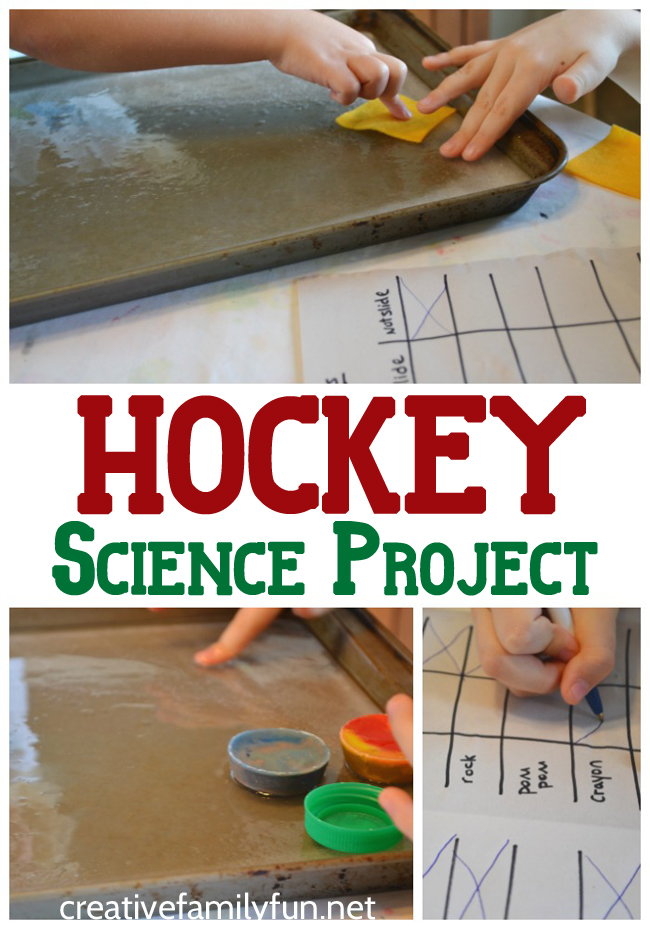Have you ever watched hockey and thought about the puck?
How fast is it going? And how does it go so fast?
Those questions inspired a fun winter science project: Hockey Science.

Can you combine hockey with science? Of course you can!
We don’t have any hockey players in our family, but we definitely have hockey fans. Hockey is a hugely popular sport here in Minnesota for both girls and boys. We thought we’d have a little fun with hockey and turned it into a simple science experiment.
Or, if your sports loving kids are looking for a fun science fair idea, this project is perfect!
Disclosure: There are Amazon Affiliate and other affiliate links in this article which means, at no additional cost to you, we could receive compensation for our recommendations. You can read our full disclosure policy on our Disclosure Page for more details.

Table of Contents
Our question: What will slide on ice?
Before we started our project, I needed to do a little prep.
I created a two-sided chart. The first side for our predictions and the second side for our results.
I also prepped a box of different items we already had on hand: glass marbles, muffin-tin crayons, milk jug caps, a rough piece of bark, a rough rock, puff balls, and small squares of felt.
Finally, I set a large sheet pan outside and filled it with water. Our sub-zero temperatures guaranteed that the water would freeze faster outside than in our own freezer. Brrrrrr! Stick your pan in the freezer if your day isn’t as cold as mine.

Make a prediction – form your hypothesis.
I showed my oldest (age 5 1/2) the items and asked her if she thought they would slide easily on the ice. I had her make her predictions by making an “x” in the appropriate box, “slide” or “not slide”.
Create your hypothesis by forming a statement: I predict ___________ will slide and ice and ____________ will not slide.

The hockey science experiment.
The experiment’s always the fun part, isn’t it?
It was time to see how well everything slid. We brought in our frozen sheet pan and started sliding our objects across it. My oldest marked our results the same way as she did our predictions.
We discovered that felt and pom poms didn’t slide like we thought they would. And those glass marbles, wow! They slid the best!
Our conclusion.
The item that were smooth and light slid better than the items that were rough or soft.
Why?
We were exploring friction with our hockey science project. The rough (or fuzzy) items had more friction which slowed the objects down. The smoother the item, the less friction which meant they slid more quickly across the ice.

By now, we had a good idea as to why a hockey puck looks like it does.
But, how fast do those things really go?
Hockey pucks generally travel over 100 miles per hour and the fastest hockey shot clocked in at 110.3 miles per hour. (Source: Guinness Book of World Records) Wow!

You may also like one of these fun science projects:
Chemical Reactions with Pennies
Ice and Snow Experiments at Inspiration Laboratories
How to Make a Magnifying Glass from Ice at Schooling a Monkey
My Must-Have Resources for Science Fun
I don’t know about you, but I don’t always have time to prep a fun science project. That’s why I love Green Kid Crafts Discovery boxes. The boxes are packed full of projects that are fun and inviting. You can choose to get a subscription or a one-off box based off of a specific theme. Any one you choose would be a lot of fun!
Here are some of our favorites (you can purchase and find out more at each link):
Find all their fun STEM and science boxes here.

STEAM Family Activities
Wouldn’t it be so much fun to get STEAM family activities delivered to your inbox? I think so! That’s why I’ve created this fun series, STEAM Family Fun, to be delivered to your inbox. After going through all the letters in STEAM each week with a fun activity devoted to each, you’ll start receiving a fun STEAM activity once a month. (And I’ll also pop up in your inbox occasionally if I’ve got other fun things to share.)
Fill out the form below to start receiving STEAM Family Fun in your inbox.

Latest posts by Terri Thompson (see all)
- Cardboard Tube Turkey Craft - October 30, 2023
- Simple and Fun Shape Crafts for Toddlers - October 25, 2023
- Thanksgiving Math Activities for Kids - November 10, 2022
